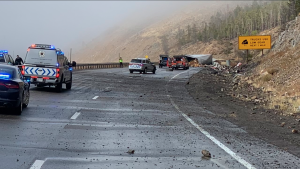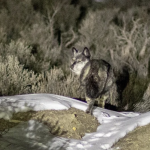Daylight saving time means extra vigilance on roads for wildlife, state agencies warn

Austin Colbert/The Aspen Times
Colorado Parks and Wildlife is partnering with Colorado Department of Transportation to raise awareness that drivers should slow down during daylight saving time to help prevent wildlife-vehicle collisions.
The end of daylight saving time occurs this Sunday, when people set clocks back an hour and experience an earlier dusk. According to a press release, as wildlife migrate to wintering habitats, they will be potentially crossing roadways during rush-hour traffic. Because of this, CPW and CDOT, along with Colorado State Patrol, is asking drivers to exercise additional caution as the cold weather that lines up with this time of year pushes wildlife into lower elevations for their yearly migrations.
“Last year, troopers responded to 3,777 crashes involving wildlife, with October, November, and December as the most active months,” Col. Matthew C. Packard, chief of the Colorado State Patrol, said in the release. “Whether it is elk in the high country or pronghorn on the plains, there is no area of our state that doesn’t have wildlife. So, it is up to all of us to remove distractions and watch out for these beautiful animals.”
In Aspen, wildlife-vehicle collisions have made up more than half of the total traffic accidents between the Sinclair gas station and the Aspen/Pitkin County Airport on Highway 82 that were reported to the police between 2013 and 2024. Animals like elk and deer follow traditional paths between different seasonal areas, and can be expected to move between those areas again and again.
Drivers in the RFV can help support local wildlife by:
- Slowing down — Traveling at high speeds increases the danger of a crash, while moderate speeds “maintain a driver’s reaction time and allow an appropriate response to animals on or near roads,” according to the release.
- Staying alert — Paying close attention to the roadway between dusk and dawn is critical when deer and other wildlife are most active and crossing roadways.
- Scanning ahead — Watching for movement and shining eyes along roadsides can help drivers spot an animal, and if there’s one animal, others should be expected in the area.
- Obeying traffic signs — Transportation authorities are attempting to reduce the number of wildlife-vehicle collisions by posting signage and lowering speeds in areas where wildlife is active.
- Giving warning — Honking the horn and flashing headlights help warn an animal to avoid the road and alert drivers to the potential hazard.
- Avoiding swerving — Swerving can cause a driver to lose control, drive into another vehicle, or drive off the road.
- Reporting collisions — Drivers involved in a wildlife-vehicle collision should report the accident to the Colorado State Patrol by calling *CSP (star key and 277).
Seatbelts are also always advised, CDOT writes, since a collision is not always avoidable. According to the release, risk of serious injury and death in a crash is reduced by half when seat belts are worn.
“We are aware that roadways can be a huge obstacle for wildlife connectivity, and that is why CDOT’s design and engineering teams continue to explore ways to include wildlife mitigation features into our highway construction projects,” CDOT Chief Engineer Keith Stefanik said in the release. “We consider it a wise investment to include features like underpasses, overpasses, and high wildlife fencing, especially when they can help reduce the number of wildlife-vehicle crashes by 80 to 90 percent.”
Wildlife mitigation features have frequently been added to planned highway improvement projects with the aim of addressing the number of wildlife-vehicle collisions in Colorado as a whole. This includes the I-70 Genesee Wildlife Crossing, the US 550 Connection South Wildlife Underpasses, and the CO 115 Penrose and Colorado Springs Wildlife Underpasses — all completed in 2024. An I-25 Greenland Wildlife Overpass, I-70 West Vail Pass Auxiliary Lanes/Wildlife Underpasses, and US 160 Fort Garland Wildlife Underpasses are all currently under construction.
In the Roaring Fork Valley, Roaring Fork Safe Passages has developed a proposed Sky Mountain Underpass, north of the Aspen/Pitkin County Airport, and Brush Creek Wildlife Overpass on Highway 82 to help alleviate some of the barriers the highway poses to wildlife.










